Native
Argyrotaenia kimballi Obraztsov (Tortricidae: Tortricinae: Archipini)
Common name: Kimball’s leafroller moth
FWLFWL:
forewing length; the distance from the base of the forewing to the apex, including fringe : 5.0-9.5 mm (males); 6.5-11 mm (females)
: 5.0-9.5 mm (males); 6.5-11 mm (females)
Argyrotaenia kimballi can usually be separated from other species of Argyrotaenia by its distinctly bicolored median fasciafascia:
a dark transverse band on the forewing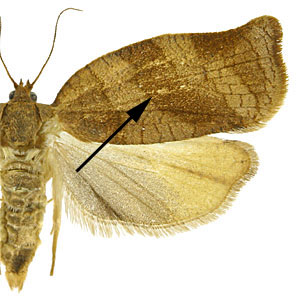 , its wide pale gray or sometimes pink-washed submedian interfascia, and the absence of a clublike projection into the median fasciafascia:
, its wide pale gray or sometimes pink-washed submedian interfascia, and the absence of a clublike projection into the median fasciafascia:
a dark transverse band on the forewing which is present in many other members of Argyrotaenia.
which is present in many other members of Argyrotaenia.
Male genitalia are characterized by a narrow, finger-like uncusuncus:
a sclerotized process which is fused to the posterodorsal margin of tergum IX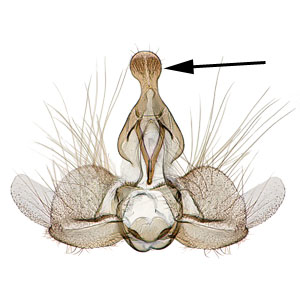 ; reduced sociisocii:
; reduced sociisocii:
a pair of lightly sclerotized setose lobes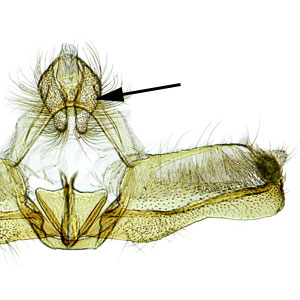 ; and rounded, membranous valvaevalva:
; and rounded, membranous valvaevalva:
an appendage flanking the intromittent organ that is used to clasp the female during copulation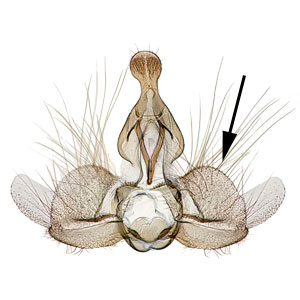 . Female genitalia are characterized by a ductus bursaeductus bursae:
. Female genitalia are characterized by a ductus bursaeductus bursae:
a membranous tube connecting the ostium bursae to the corpus bursae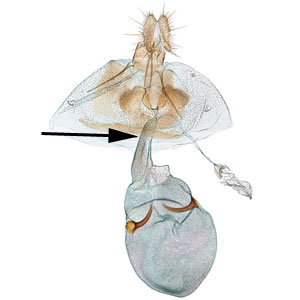 with a sclerotizedsclerotized:
with a sclerotizedsclerotized:
hardened; usually in reference to larval structures or adult genitalia  plate near the ostiumostium:
plate near the ostiumostium:
see ostium bursae 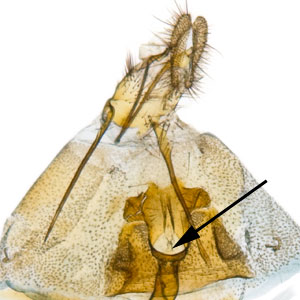 and a large, hook-shaped signumsignum:
and a large, hook-shaped signumsignum:
a sclerotized projection or patch on the interior of the corpus bursae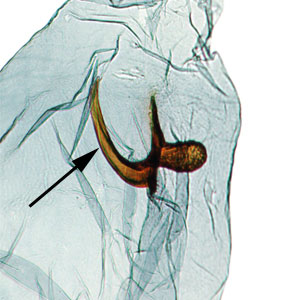 in the corpus bursaecorpus bursae:
in the corpus bursaecorpus bursae:
a dilated membranous sac at the anterior end of the bursa copulatrix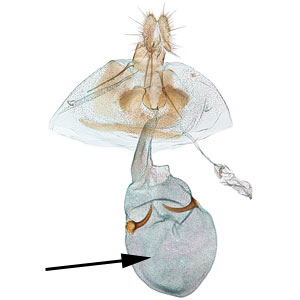 with a well-developed capitulumcapitulum:
with a well-developed capitulumcapitulum:
in reference to the female signum; a knoblike projection 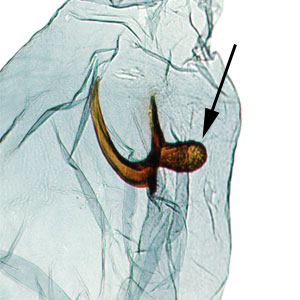 .
.
Larval morphology is unknown for this species.
Argyrotaenia kimballi is very similar to several other species of Argyrotaenia, such as A. pinatubana and A. velutinana, but both of these species lack the gray- or pink-washed interfasciae present in A. kimballi. The median fasciafascia:
a dark transverse band on the forewing , though occasionally bicolored in these two species, is never as strongly contrasting as in A. kimballi.
, though occasionally bicolored in these two species, is never as strongly contrasting as in A. kimballi.
Bullock et al. (1997) reported A. kimballi being an occasional and minor Citrus pest in Florida. Larvae tie three or four young terminal leaves together and feed on fresh leaves of surrounding branches as well as the wilting leaves which have been tied together. They reportedly feed on the fruit as well as the leaves. Though Citrus is its only current reported hostplant, it is likely polyphagous. Its host plant usage in other areas of its range is unknown.
| Host plant | Host plant family | Reference(s) |
| Citrus sp. | Rutaceae | Bullock et al. 1998Bullock et al. 1998: Bullock, R. C., Killer, E. E., Pelosi, R. R. 1998. Population dynamic and citrus fruit damage by two species of leafroller, Argyrotaenia amatana and Argyrotaenia kimballi (Lepidoptera: Tortricidae). Proceedings of the Florida State Horticultural Society. 110. 27-32. |
View full screen host table here
Argyrotaenia kimballi is distributed in the southeastern United States, from Maryland south to Florida and west to Texas and Arkansas. It is also known from The Bahamas (Austin et al. 2019Austin et al. 2019:
Austin, K. A., Dombroskie, J. J., Matthews, D. L., Miller, J. Y. 2019. A review of the Archipini of The Bahamas with the description of a new species of Argyrotaenia Stephens (Tortricidae). Journal of the Lepidopteristsrsquo; Society. 73(1): 5-17.).